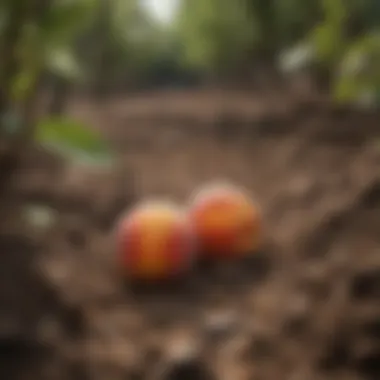Optimal Fertilizers for Thriving Peach Trees


Intro
Understanding the nutritional needs of peach trees is crucial for successful cultivation. Peach trees require specific nutrients during various growth stages that directly impact their fruit yield and overall health. This guide aims to clarify which fertilizers are optimal for peach trees, helping growers make informed choices that align with their specific agricultural practices.
In the following sections, we will dissect the specific nutrient requirements for peach trees, examine the impact of different fertilizers, and provide practical application tips. Additionally, we will delve into factors affecting fertilizer choice, which can significantly influence both short-term growth and long-term sustainability in peach farming.
This comprehensive oversight will empower cultivators to enhance the productivity of their peach trees while ensuring ecological balance.
Fascinating Facts About Peach Trees
Peach trees are remarkable organisms with unique characteristics that set them apart from other fruit-bearing trees. Understanding these facts can enrich the cultivation experience.
Unique Characteristics
- Peach trees belong to the Prunus genus, which also includes plums, cherries, and apricots.
- They typically live for about 15 to 20 years, with some cultivars lasting longer.
- Blossoms appear early in spring, often before the leaves, which is an attractive feature for many gardeners.
Extraordinary Abilities
Peach trees are particularly adept at adapting to different soil types, although they thrive best in well-drained, sandy loams. Their root systems are effective at extracting moisture and nutrients from the soil, supporting their vigorous growth.
Understanding Peach Tree Nutritional Needs
Understanding the nutritional needs of peach trees is crucial for their optimal growth and fruit production. Peach trees require specific nutrients at various stages of their life cycle. By addressing these needs, growers can enhance the health of their trees and ensure a fruitful harvest. Key elements to consider include the types of nutrients required, the symptoms of deficiencies, and the overall impact on tree performance.
Essential Nutrients for Peach Trees
Macronutrients Overview
Macronutrients play a significant role in the development of peach trees. These include nitrogen, phosphorus, potassium, calcium, magnesium, and sulfur. Each of these nutrients contributes to various functions, such as leaf growth, root development, and overall tree vigor. Nitrogen, for example, promotes healthy foliage and robust growth, making it vital for young trees. Phosphorus supports root establishment and flowering, essential for fruit set. Potassium is crucial for fruit quality and disease resistance.
A notable characteristic of macronutrients is their requirement in larger quantities compared to micronutrients. This makes them a popular choice when discussing fertilization options. However, improper levels can lead to imbalances that negatively affect the trees. Each macronutrient has its unique feature—for instance, nitrogen can encourage excessive growth at the cost of fruit production if not managed properly.
Micronutrients Importance
Micronutrients, though required in smaller amounts, are equally essential for peach tree health. These include iron, manganese, zinc, copper, boron, and molybdenum. Each plays a critical role in various physiological processes, such as photosynthesis and enzyme function. For instance, iron is crucial for chlorophyll production, while boron relates to flower and fruit development.
The key characteristic of micronutrients is their role in enhancing metabolic processes and optimizing health. Their importance lies in the fact that deficiencies can lead to serious symptoms, like blossom drop or poor fruit quality. Yet, they are sometimes overlooked in fertilization plans, which can become a disadvantage if soil tests do not adequately account for them.
Nutrient Deficiencies and Symptoms
Identifying Nutrient Deficiencies
Identifying nutrient deficiencies in peach trees is essential for maintaining their health. Nutrient deficiencies often manifest as physical symptoms in the tree, such as yellow leaves, stunted growth, or poor fruit development. These symptoms can signal the need for specific nutrients. For example, yellowing leaves may indicate a nitrogen deficiency, while purpling might suggest a phosphorus issue.
The key characteristic of this identification process is its reliance on visual cues and soil testing. This makes it beneficial because early detection allows corrective measures to be taken before severe damage occurs. Learning to recognize symptoms can assist growers in understanding the right type of fertilizer needed, avoiding guesswork and ensuring a tailor-fit solution.
Impact on Tree Health and Productivity
The impact of nutrient deficiencies on tree health and productivity can be significant. Nutrient deficiencies not only affect the immediate growth of peach trees but can also compromise their ability to produce quality fruits. For example, insufficient potassium can lead to poorly-sized fruit and a drop in sugar content, directly affecting flavor and marketability.


The key characteristic of this impact is its long-term effect on both tree vigor and fruit output. This makes it an important consideration for growers seeking to optimize their harvests. Recognizing that poor nutrient management can lead to declines in tree health over time serves as a cautionary note for all orchardists.
Types of Fertilizers Suitable for Peach Trees
Selecting the right fertilizers for peach trees is crucial to their health and productivity. Different fertilizers offer varying nutrients and characteristics. Understanding these differences can help growers achieve optimal results for their crops. The choice between types of fertilizers is influenced by various factors, including soil composition, tree age, and climate conditions. This section explores these factors in detail.
Inorganic vs Organic Fertilizers
Benefits of Inorganic Fertilizers
Inorganic fertilizers are often preferred by many growers because they provide immediate nutrient availability. These fertilizers contain synthetic compounds that deliver nutrients directly to the plant. One significant benefit is their ability to supply higher nutrient concentrations compared to organic substitutes. It means that less quantity is needed for application. Moreover, their quick availability enhances nutrient uptake in periods when the trees need support, such as during growth phases. However, the high solubility can lead to nutrient leaching, causing environmental concerns.
Advantages of Organic Options
Organic fertilizers, on the other hand, have become increasingly popular. Their primary advantage lies in improving soil structure and health over time. These fertilizers release nutrients slowly, providing a steady supply to the trees. This slower release can lead to healthier root systems and better overall growth. Organic options are especially beneficial in promoting biodiversity and supporting beneficial soil organisms. However, it often requires more frequent application to meet the nutrient demands of the peach trees, making them potentially less convenient for some growers.
Slow-Release vs Quick-Release Fertilizers
Characteristics of Slow-Release Fertilizers
Slow-release fertilizers are designed to provide nutrients over an extended period. They encapsulate nutrients in a way that regulates their availability. A key characteristic of these fertilizers is their ability to match the nutrient release to the growth stages of the peach trees. This can lead to improved nutrient efficiency and reduces the risk of nutrient burn. While they may be slightly more expensive, their long-term benefits in promoting tree health can outweigh initial costs. It’s a choice some growers find suitable for ensuring consistency in nutrient availability.
Effects of Quick-Release Options
Quick-release fertilizers offer rapid nutrient availability. They can be beneficial during specific growth stages when trees need immediate support. These fertilizers allow for quick responses to deficiencies. However, their key characteristic of fast-acting nature can result in uneven nutrient uptake. Thus, there is a risk of over-fertilization. This can harm the tree and the environment. Growers must consider application timing carefully to avoid such issues.
Specialized Peach Tree Fertilizers
Formulations for Optimal Growth
Specialized fertilizers are formulated specifically for peach trees. These products often combine essential nutrients tailored to the growth needs of the trees. Among their benefits is ensuring that all necessary macronutrients and micronutrients are available in the right ratios. This targeted approach can lead to better health and more substantial yields. However, these formulations sometimes come at a premium price, limiting access for some growers.
Fertilizers with Added Micronutrients
These fertilizers enhance the nutritional profile of standard fertilizers. By adding micronutrients, they address specific deficiencies that might affect peach trees. Essential micronutrients like zinc, iron, and manganese play vital roles in overall tree health. The key characteristic of these fertilizers is their ability to improve not only the health of the tree but also the quality of the fruit produced. However, finding a balance in applying these fertilizers is important, as excessive micronutrient application can lead to toxicity.
Understanding the varying types of fertilizers and their specific characteristics can greatly enhance the productivity of peach trees, ensuring healthy growth and optimal fruit yield.
Factors to Consider When Choosing Fertilizer
Selecting the right fertilizer for peach trees involves careful consideration of multiple factors that directly affect their growth and yield. Understanding soil composition, pH levels, climate, and environmental conditions is essential. Each of these elements plays a significant role in determining the effectiveness of fertilization. Adequate knowledge in this area can lead to better fruit production and overall tree health.
Soil Composition and pH Levels
Soil Testing Methods
Soil testing offers insights into the nutrient content and pH levels of the soil where peach trees grow. This method analyzes samples to assess nutrient deficiencies or excesses. One key feature of soil testing is that it allows for specific fertilizers to be chosen based on the actual needs of the soil. This is a beneficial choice for growers who want to maximize tree health without over-fertilizing.
The unique feature of soil testing is the ability to identify micro-nutrient needs. By measuring pH and nutrient levels, growers can make informed decisions. However, the process does require time and skill, which may be a disadvantage for those new to gardening.


Adjusting Soil pH for Peach Trees
Adjusting soil pH is crucial for establishing a beneficial environment for peach trees. Peach trees thrive in slightly acidic to neutral soils, ideally with a pH between 6.0 and 7.0. The key characteristic of this adjustment is that it influences nutrient availability in the soil. By bringing soil pH levels to the optimal range, nutrient absorption is enhanced, leading to better tree performance.
One unique aspect of pH adjustment is the use of sulfur or lime. These substances can either lower or raise pH levels as needed. However, these adjustments can take time to show results, which may be a drawback for growers looking for immediate effects.
Climate and Environmental Conditions
Regional Climate Considerations
The regional climate significantly affects fertilizer choices for peach trees. Climatic factors such as temperature, rainfall, and humidity can influence the growth process. A crucial aspect of understanding these conditions is that they dictate the timing and type of fertilizer application. Growers must consider the specific climate in their area to apply fertilizers effectively and safely.
In regions with severe winters or excessively hot summers, choosing fertilizers that can withstand temperature extremes is essential. The advantage here is that tailored fertilization strategies can yield better tree health and fruit production. However, the disadvantage is that regional variability may complicate decision-making for growers unfamiliar with local conditions.
Seasonal Fertilization Practices
Seasonal fertilization practices involve applying fertilizer at specific times throughout the year. This method ensures that peach trees receive nutrients when they need them most. A key characteristic of these practices is that they align nutrient availability with the tree's growth stages. This leads to healthier growth and fruiting.
The unique feature here is the importance of spring and fall applications. For instance, early spring offers a prime opportunity for nitrogen-rich fertilizers, while a late fall application supports root health before winter. However, timing must be precise, as late applications can lead to nutrient runoff and environmental concerns, which are drawbacks that need careful consideration.
Best Practices for Fertilizing Peach Trees
Understanding the best practices for fertilizing peach trees is crucial for optimizing their growth and fruit yield. Applying fertilizers correctly ensures that trees receive essential nutrients at the right time and in appropriate amounts. Proper fertilization not only affects the health of trees but also enhances the quality of the peaches produced. A knowledgeable approach to fertilizing contributes to long-term tree vitality.
Timing and Frequency of Application
Fertilization Schedule
A fertilizer schedule is a plan that details the timing and amount of fertilizer to be applied during the growing season. It is vital for promoting healthy growth in peach trees. A well-structured schedule can lead to improved nutrient uptake and reduce the risk of nutrient imbalances. One key characteristic of a fertilization schedule is its alignment with the growth stages of peach trees, including flowering, fruit set, and ripening.
Unique features of a good fertilization schedule may include a mix of slow-release and quick-release fertilizers timed according to the specific needs of the trees at different growth stages. For instance, applying a slow-release fertilizer in early spring can support steady growth, while a quick-release formula might be useful right before fruit setting. Such scheduling practices can greatly enhance tree health.
Signs of Over or Under-Fertilization
Recognizing signs of over or under-fertilization is essential for maintaining the balance of nutrients in peach trees. Over-fertilization can lead to excessive vegetative growth at the expense of fruit production. This often manifests as lush, green leaves but fewer fruits. In contrast, under-fertilization may cause stunted growth and yellowing leaves, indicating a lack of essential nutrients.
One significant aspect is the visual symptoms that can guide growers. For instance, leaf tip burn may indicate too much nitrogen, while poor fruit development may point to insufficient potassium. Diagnosing these signs accurately can lead to timely adjustments in fertilization strategies. Therefore, understanding the indicators of proper fertilization is beneficial and necessary for long-term peach tree health.
Methods of Application
Broadcasting Techniques
Broadcasting techniques involve evenly spreading fertilizer across the soil surface around the tree's root zone. This method is popular due to its simplicity and ability to cover large areas quickly. The key characteristic of broadcasting is the uniform distribution of nutrients, which can prevent localized nutrient depletion.
The unique feature of this method is its potential to utilize both granular and powdered fertilizers effectively. However, growers must be cautious as excessive application or poor timing can lead to nutrient runoff. This can harm both the tree and the surrounding environment. Thus, understanding when and how much to apply is essential for optimizing the effectiveness of this technique.
Root Zone Application
Root zone application focuses on delivering nutrients directly to the area where the tree's roots can best absorb them. This method is particularly effective for ensuring that fertilizers reach the root system promptly, potentially improving nutrient uptake efficiency. It is a practical choice when targeting specific nutrient deficiencies.


Key advantages of root zone application include reduced waste of fertilizers and minimizing runoff into the environment. For instance, applying fertilizers in the planting hole at the time of planting can enhance early root development. However, this method may require more labor and expertise to execute correctly. Therefore, careful planning is essential to maximize the benefits of root zone fertilization.
In summary, understanding these best practices enhances the ability to cultivate healthy, productive peach trees.
Assessing the Impact of Fertilization
Assessing the impact of fertilization is crucial for understanding how various treatments influence peach tree growth and productivity. Through proper evaluation, growers can identify which fertilizers work best for their trees and optimize their application practices. This section focuses on how to measure tree health and growth and evaluate fruit quality and yield improvements. The key takeaway is that a systematic assessment informs better decisions about fertilization, ensuring that the peach trees reach their maximum potential.
Measuring Tree Health and Growth
Growth Metrics to Monitor
Monitoring growth metrics is essential for evaluating the health of peach trees. Key aspects include trunk diameter, shoot length, and leaf area. These indicators reflect the overall vitality of the tree and its response to fertilization. For instance, increased trunk diameter typically suggests improved nutrient uptake, while longer shoots indicate vigorous growth.
One of the defining characteristics of growth metrics is that they provide quantifiable data, making it easier to track progress over time. This objectivity is beneficial for growers who want to see tangible results from their fertilization efforts. However, a potential drawback is that some metrics may take longer to show significant changes, which requires patient observation and understanding.
Long-Term Health Assessments
Conducting long-term health assessments offers valuable insights into the sustained effects of fertilization. This can encompass evaluating overall tree vigor, monitoring disease resistance, and observing flowering and fruiting patterns. A critical characteristic of long-term assessments is their ability to showcase trends over multiple growing seasons, allowing for informed adjustments in fertilization strategies.
The unique aspect of long-term health assessments is that they reflect not only the immediate impact of fertilizers but also their lasting influence on peach trees. However, these assessments require time investment and consistent monitoring, which can be challenging for some growers.
Fruit Quality and Yield Improvements
Assessing Fruit Size and Flavor
Evaluating fruit size and flavor is fundamental to measuring the success of fertilization practices. Larger fruits often indicate better nutrient uptake, resulting in improved marketability. Flavor is equally important, as it affects consumer preferences and overall satisfaction. A key characteristic of this assessment is that it combines both quantitative and qualitative measures.
The unique feature of assessing fruit size and flavor lies in its direct connection to the economic viability of peach production. However, subjective preferences can vary among consumers, making it necessary to consider a broader audience for meaningful evaluations.
Evaluating Harvest Yields
Harvest yield evaluation is a pivotal aspect of assessing the impact of fertilization. It encompasses the total quantity of fruit produced, which directly correlates with economic returns. A critical element of this evaluation is understanding the relationship between yield and fertilization strategies employed. By consistently gathering yield data, growers can adjust their fertilization techniques to maximize production.
The distinctive nature of evaluating harvest yields is that it provides concrete evidence of the effectiveness of chosen fertilizers. Yet, high yields may not always mean high quality, presenting a challenge for growers in reconciling quantity with the desired quality attributes.
In summary, assessing the impact of fertilization is vital to achieving optimal peach tree health. By meticulously measuring growth metrics and evaluating fruit quality and yield, growers can refine their fertilizer applications and make more educated decisions for future seasons.
Culmination
Understanding the optimal fertilization for peach trees is critical to ensure healthy growth and maximum fruit production. This article outlines essential insights into the nutrient needs of peach trees, the different types of fertilizers available, and the best practices for application. By grasping these concepts, growers can significantly impact their trees' vitality and productivity.
Summary of Key Insights
The vital points covered in this article include:
- Essential Nutrients: Peach trees require a balanced intake of macronutrients like nitrogen, phosphorus, and potassium, as well as micronutrients for overall health.
- Fertilizer Types: A comprehensive look at both inorganic and organic fertilizers helps readers understand the benefits and potential drawbacks of each.
- Application Techniques: Proper methods of fertilizing, including timing and frequency, are crucial to achieve optimal results.
- Assessing Impact: Monitoring tree health and fruit quality after applying fertilizers ensures that the approach meets the goals of the grower.
These insights not only provide a foundational understanding but also guide practical applications that can lead to fruitful harvests.
Future Directions in Peach Tree Fertilization Research
Looking ahead, there is significant potential for advancement in peach tree fertilization practices. Research can focus on several areas:
- Precision Agriculture: Utilizing technology for soil and nutrient management can lead to tailored fertilization approaches, enhancing efficiency and reducing waste.
- Sustainable Practices: As environmental concerns grow, finding refined organic fertilizers or alternative methods that do less harm to soil ecosystems will be essential.
- Nutrient Uptake Studies: Further studies examining how different varieties of peach trees uptake nutrients can help develop custom fertilizers suited for specific needs.
Engaging in such research will allow growers to implement cutting-edge practices, maximizing yield while maintaining tree health and environmental sustainability.







